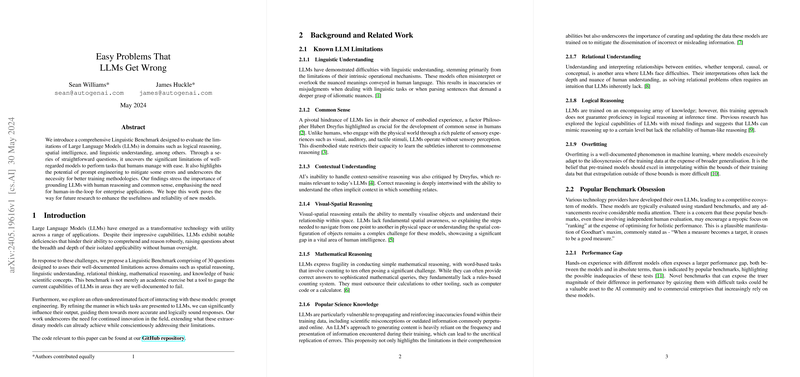Analysis of "Easy Problems That LLMs Get Wrong"
The paper "Easy Problems That LLMs Get Wrong" by Sean Williams and James Huckle presents a critical evaluation of LLMs using a newly developed Linguistic Benchmark. The work investigates foundational limitations in LLMs concerning logic, language comprehension, and spatial reasoning, among others. Williams and Huckle's paper highlights a methodological approach that goes beyond prevailing benchmarks to expose deficits in seemingly trivial tasks from a human cognitive perspective.
Overview
The authors devise a benchmark comprising 30 questions designed to exemplify limitations across several core cognitive domains. These domains include logical reasoning, visual-spatial awareness, mathematical problem-solving, and relational understanding, all key areas where LLMs, despite their advancements, often falter as compared to human cognitive abilities. The results expose inadequacies that could impact the deployment of LLMs in applications requiring nuanced decision-making and reasoning without human input.
Methodology
The methodology involves a structured interrogation of various prominent LLMs from industry leaders such as OpenAI and Google. The authors use straightforward questions designed specifically to demonstrate known deficiencies and assess the models' capabilities against a human benchmark. This task is particularly crucial given the tendency for LLMs to overfit to datasets representative of internet text, thus failing in novel, structured problem domains.
A notable aspect of this paper is the examination of the utility of prompt engineering. By refining prompt structure, the authors demonstrate measurable improvements in LLM responses, thereby underscoring the potential of prompt engineering to enhance accuracy.
Results
The paper presents detailed empirical results highlighting low average scores across the tested LLMs, with OpenAI's GPT-4 Turbo achieving 38% accuracy, illustrating substantial room for improvement when compared to human performance scores. Notably, the benchmarking process includes confidence interval analyses which reveal statistical disparities between LLM outputs and suggested competent human reasoning.
Subsequent experiments exploring clarifying questions exhibit a notable relative improvement of 40.7%, suggesting that modifications to input might significantly influence output quality. Despite this, certain aspects such as the inherent non-determinism of LLM outputs and the susceptibility of benchmarks to overfitting remain unresolved challenges.
Discussion
The findings illuminate several domains where LLMs, despite their capacity for large-scale text processing, lack fundamental human-like reasoning capabilities. Critical limitations include logical inconsistency, spatial reasoning failures, and arithmetic inaccuracies. These deficiencies are juxtaposed against LLM performance on existing benchmarks, provoking discourse on the potential misalignment between benchmark optimization and generalized model efficacy.
The work illustrates the tendency of LLMs to rely excessively on learned patterns rather than adaptive reasoning, a shortcoming explicit in the examples of overfitted task responses like the Monty Hall Problem. This insight encourages innovation in training methodologies that emphasize robustness over merely scaling model dimensions.
Implications
Practically, these insights suggest a necessity for integrating LLMs with human oversight in applications to mitigate errors stemming from their reasoning deficits. The persistent issues with overfitting necessitate a rethinking of both training datasets and evaluation benchmarks to better reflect real-world applications. Furthermore, this research emphasizes the need for transparent communication about current LLM capabilities and emphasizes accountability in their deployment.
Conclusion
Williams and Huckle's examination offers a sobering reflection on the status of LLMs vis-a-vis human reasoning. While their adaptability to new prompts holds promise, the evident deficiencies in handling ostensibly simple tasks serve as a timely caution for developing systems with reliable, human-parallel reasoning abilities. Future research that examines model reliability and input-output determinism comprehensively could pave the way toward more capable, trustworthy AI systems, highlighting the importance of a balanced approach to evaluation that incorporates novel, real-world complexities.
